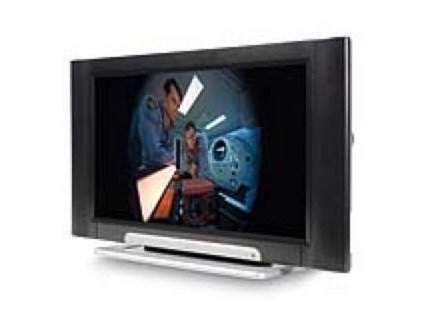TechRadar Verdict
In the haste to cut prices a decent picture has been abandoned
Pros
- +
Inexpensive and fairly good looking
Cons
- -
Important corners have been cut in favour of low pricing
Why you can trust TechRadar
Having little time to pause for breath after the JVC LT-32DS75's price revelation, the air is snatched from our lungs once again with the Hitachi 32LD6600's £700 price tag. Our eyes are well and truly peeled for the catch here, and it doesn't take us very long to find the Achilles heel in the most obvious place.
The bargain-basement price isn't reflected in this Hitachi's design. The black finish cuts a certain amount of charm, giving the TV the sort of looks that wouldn't disgrace any living room. Equally pleasing is this set's connectivity, obviously within the context of the low price: there's a single HDMI jack and a set of component video jacks for high-definition donkey work, as well as a PC VGA input and a couple of Scarts.
Here comes the first omission: there isn't a digital tuner. As most sets come with a digital tuner - to pick up the Freeview terrestrial TV service - the absence here doesn't auger well. Especially as adding one wouldn't push the TV's asking price up very far.
That said a Freeview adapter can cost under £30, and if you subscribe to ntl:Telewest or Sky's HD services, your standard-def digital TV needs will be catered for anyway, so this isn't really a great loss.
The cupboard's pretty much bare in terms of features. All that's worth a mention are Dynamic Bass and 3D Surround audio processing, optional 3D comb filter and video noise reduction - even they aren't worth getting worked up about.
Awful picture
With the main event of 2001: A Space Odyssey up and running, this bargain TV soon has its cheerful stripes unceremoniously ripped from its fascia: the picture is awful. Colours during astronaut Bowman's psychedelic journey through the Monolith are hit and miss. Tones look aggressive during this dynamic scene too, while elsewhere, they are muted and inauthentic.
Skin tones look natural in some scenes and alien in the next. In short colours are a real dog's breakfast. Black levels are mediocre, really draining the choreographed beauty from the Strauss-accompanied spaceship docking sequence. During this scene, the spaceship trudges through a mist of grayness into which background detail vanishes: less a black hole and more a grey one.
Sign up for breaking news, reviews, opinion, top tech deals, and more.
In light of this, it's no shock to discover that the picture is really soft too. A quick blast of an HD transmission of Planet Earth sees this Hitachi falling at the first hurdle in terms of delivering a clear and sharp picture. Our mortal enemy of motion blur is clipping at its heels too.
To be kind to this TV's awful pictures, noise levels are well contained and brightness is adequate: but, if that's the best we've got to say on the matter, it's lean pickings indeed.
Sonically speaking, there is a marked improv'ement on the pictures. The bass and treble are no great shakes, but the mid-range is open enough and conveys the musical score with reasonable clarity. Dialogue is also delivered adequately.
Even if this Hitachi turned out to be the greatest sonic performer on the 32in LCD scene, it would be too little, too late. In light of this performance, £700 sounds like a fortune for this set.
Christmas comes early for this Hitachi: pass the stuffing, as this is a real turkey of an LCD TV.
Tech.co.uk was the former name of TechRadar.com. Its staff were at the forefront of the digital publishing revolution, and spearheaded the move to bring consumer technology journalism to its natural home – online. Many of the current TechRadar staff started life a Tech.co.uk staff writer, covering everything from the emerging smartphone market to the evolving market of personal computers. Think of it as the building blocks of the TechRadar you love today.
